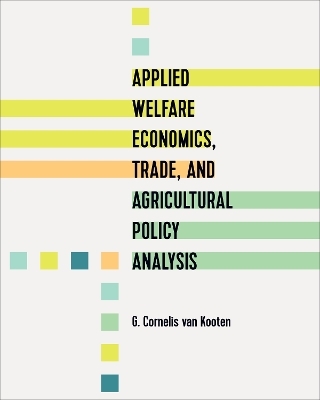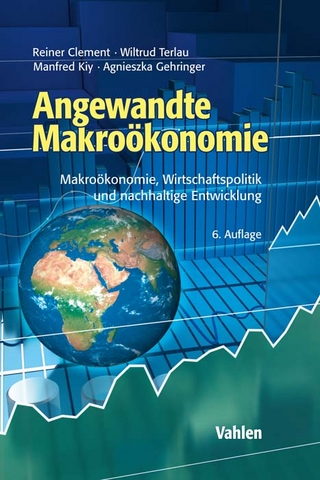
Applied Welfare Economics, Trade, and Agricultural Policy Analysis
University of Toronto Press (Verlag)
978-1-4875-0607-0 (ISBN)
This textbook integrates three related fields in economics, namely agricultural/forestry economics, environmental economics, and international trade, by foregrounding cost-benefit analysis as a significant policy tool.
Exploring how welfare measures can be used in the analysis of agricultural, trade, and other economic policies, Applied Welfare Economics, Trade, and Agricultural Policy Analysis fills a gap in the literature on agricultural policy analysis by explaining the economic efficiency improvements and income transfers of various agricultural policy reforms in the United States, Canada, and the European Union.
G. Cornelis van Kooten addresses methods of identifying and measuring economic surpluses (costs and benefits), the precautionary principle, identification of an appropriate discount rate, the importance of non-market values, and the role of agriculture in trade negotiations and climate change. Applied Welfare Economics, Trade, and Agricultural Policy Analysis draws on new research, brings attention to the existing literature, and includes review questions that challenge programming skills. The techniques developed in this text can be applied to the development and reform of agricultural policies in various regions in response to trade negotiations and many other situations involving government policy.
G. Cornelis Van Kooten is a professor of Economics and Canada Research Chair in Environmental Studies and Climate at the University of Victoria.
List of Tables
List of Figures
List of Acronyms
Chapter 1. Introduction
1.1 Setting the Agricultural Stage
1.1.1 Top Agricultural Commodity Producers
1.1.2 Food Security: Green Revolution and Crop Yields
1.2 Structure of the Book
Guide to Literature
Chapter 2. Project Evaluation Criteria
2.1 Private Financial Analysis
2.1.1 Financial Ranking Criteria
2.1.2 Conclusion
2.2 Society’s Perspective: Social Cost-Benefit Analysis
2.2.1 Benefits and Costs as Rent and Surplus
2.2.2 The Fundamental Equation of Applied Welfare Economics
2.2.3 Total Economic Value
2.2.4 Total (Average) Value Versus Marginal Value
2.2.5 Conclusion
2.3 Multiple Accounts and Alternative Criteria
2.3.1 Environmental Quality
2.3.2 Regional Economic Development and Employment: Indirect Benefits
2.3.3 Other Social Effects
2.3.4 Concluding Observations about Multiple Accounts
2.4 Alternative Methods for Evaluating Projects
2.4.1 Cost-Effectiveness Analysis
2.4.2 Multiple Criteria Decision Making
2.4.3 Life-Cycle Assessment
2.4.4 Cumulative Effects Analysis
2.5 Extreme Events and Irreversibility
2.6 Discounting and Choice of Discount Rate
2.6.1 Dilemmas in Choosing a Discount Rate in Cost-Benefit Analysis
2.6.2 Risk Adjusted Discount Rates
2.6.3 Discounting in an Intergenerational Context
Guide to the Literature
Food for Thought
Chapter 3. Externalities and Nonmarket Valuation
3.1 Cost Function Approach
3.2 Expenditure Function
3.2.1 Hedonic Pricing
3.2.2 Recreation Demand and the Travel Cost Method
3.3 Contingent Methods or Direct Approaches
3.3.1 Contingent Valuation Method
3.3.2 Choice Experiments/Stated Preferences
3.3.3 Constructed Preferences/Stakeholder Method
3.3.4 Fuzzy and ad hoc Methods for Determining Nonmarket Values
3.4 Benefit Transfer
3.5 Concluding Discussion
Guide to Literature
Food for Thought
Chapter 4. International Trade and Applied Welfare Analysis
4.1 Spatial Price Equilibrium Trade Modelling
4.2 Unrestricted Free Trade
4.3 Trade and the Measurement of Wellbeing in Multiple Markets
4.3.1 Vertical Chains
4.3.2 Vertical and Horizontal Chains
4.4 Economic Policy and Trade: Examples
4.4.1 EU Import Restrictions on Canadian Durum Wheat
4.4.2 Incentivizing Anti-Dumping and Countervail Duty Complaints: Byrd Amendment
4.4.3 Restricting Log Exports
4.5 Concluding Discussion
Appendix 4.A: Mathematics of Supply Restrictions
Appendix 4.B: Calculation of Objective Function in SPE Models
Guide to Literature
Food for Thought
Chapter 5. Governance, Rent-Seeking, Global Trade and the Agreement on Agriculture
5.1 Institutions and Governance
5.1.1 Models of Government
5.1.2 Takings
5.1.3 Institutions
5.1.4 Financing Government and Public Projects
5.2 Land Use and the Principal-Agent Problem
5.3 International Trade Negotiations and Agriculture
5.3.1 Agreement on Agriculture
5.3.2 Agreement on Subsidies and Countervail Measures
5.4 Tariff Rate Quota (TRQ)
5.5 Concluding Discussion
Guide to Literature
Food for Thought
Chapter 6. Analysis of Agricultural Policy: Theory
6.1 Background to Analysis of Agricultural Policy
6.2 Stock-Holding Buffer Fund Stabilization
6.3 Quotas and Supply-Restricting Marketing Boards
6.3.1 Quota and General Equilibrium Welfare Measurement
6.3.2 Quota Buyouts
6.3.3 Designing and Dismantling a Multi-Region Quota Program
6.4 Price Discrimination
6.5 Agricultural Technology: Genetically Modified Organisms
6.5.1 Agricultural Research and Development
6.5.2 Genetically Modified Organisms
6.6 Measuring Externalities in Agriculture
6.7 Concluding Discussion
Guide to Literature
Food for Thought
Chapter 7. Agricultural Policies in the U.S. and Canada
7.1 Agricultural Support: A Brief Overview
7.2 U.S. Agricultural Policy
7.2.1 Analysis of U.S. Price Support Programs
7.2.2 Reducing Production and Disposing of Excess Grain
7.2.3 Decoupling
7.2.4 Moving Forward
7.3 Canadian Agricultural Policy
7.3.1 State Trading: The Canadian Wheat Board (1935-2012)
7.3.2 Crop Insurance
7.3.3 Western Grain Stabilization Act (1976)
7.3.4 Transportation Programs and Subsidies
7.3.5 Supply Management
7.5 Concluding Discussion
Guide to Literature
Food for Thought
Chapter 8. Agricultural Policy in Europe and Asia
8.1 Agricultural Policy Reform in the European Union
8.1.1 Background to the European Union
8.1.2 High and Increasing Costs of Agricultural Programs
8.1.3 Integration of New Members
8.1.4 Reform of the CAP and Increasing Environmental Concerns
8.1.5 Further Analysis of Sector-Level Programs
8.1.6 Brexit
8.2 Agriculture in Developing Countries
8.2.1 Economy-wide Economic Reform and Chinese Agriculture
8.2.2 India and the Rice Economy
Guide to Literature
Food for Thought
Chapter 9. Agricultural Business Risk Management
9.1 Privatizing Agricultural Hedges: Financial Products versus Insurance
9.1.1 Index Insurance and Derivatives
9.1.2 Futures Trading and Options
9.2 Agricultural Business Risk Management in the United States
9.2.1 Deep Loss Protection: The Federal Crop Insurance Program
9.2.2 Agricultural Business Risk Management Programs in the 2008 Farm Bill
9.2.3 Agricultural Business Risk Programs in the 2014 and 2018 Farm Bills
9.2.4 Dairy
9.2.5 Trade Issues
9.3 Agricultural Business Risk Management in Canada
9.3.1 The Shift from Price Support to Risk Management
9.3.2 Enter Growing Forward
9.3.3 Shift from Growing Forward (GF) to Growing Forward 2 (GF2)
9.3.4 Evaluation of Canada’s Agricultural Business Risk Programs
9.3.5 Going Forward: Canadian Agricultural Partnership
9.4 Concluding Discussion: Lessons for Agricultural Business Risk Management
9.4.1 Do Agricultural BRM Programs Distort Production?
9.4.2 Comparison of U.S. and Canadian Approaches to Risk Management
Appendix 9.A: A Brief Look at the Economics of Risk and Risk Aversion
9.A.1 Systemic versus Idiosyncratic Risk
9.A.2 Expected Income Maximization and the Risk Aversion Coefficient
Guide to Literature
Food for Thought
Chapter 10. Climate Change and Applied Welfare Economics
10.1 Anthropogenic Climate Change and its Impact
10.1.1 Climate Sensitivity
10.1.2 Damages
10.2 Economic Evaluation: The Role of Integrated Assessment Models
10.2.1 Climate Models and Policy Models
10.2.2 Carbon Price Policy Variable
10.3 Economic Impacts of Climate Change on Agriculture
10.3.1 Land Rents and the Regression Approach
10.3.2 Mathematical Representation of Landowner Decisions
10.4 Climate Change and Food Security
10.5 Discounting and Climate Urgency
10.5.1 Discounting Carbon
10.5.2 Economics of Wood Biomass Energy: Climate Urgency and Discounting
10.6 Mitigating Climate Change
10.6.1 International Action to Mitigate Climate Change
10.6.2 Agricultural Role in Mitigating Climate Change
10.6.3 Managing for Carbon: Carbon Pools and Fossil Fuel Substitution
10.7 Discussion
Guide to Literature
Food for Thought
References
| Erscheinungsdatum | 05.07.2021 |
|---|---|
| Zusatzinfo | 70 figures |
| Verlagsort | Toronto |
| Sprache | englisch |
| Maße | 211 x 264 mm |
| Gewicht | 840 g |
| Themenwelt | Wirtschaft ► Volkswirtschaftslehre ► Makroökonomie |
| ISBN-10 | 1-4875-0607-4 / 1487506074 |
| ISBN-13 | 978-1-4875-0607-0 / 9781487506070 |
| Zustand | Neuware |
| Haben Sie eine Frage zum Produkt? |
aus dem Bereich


